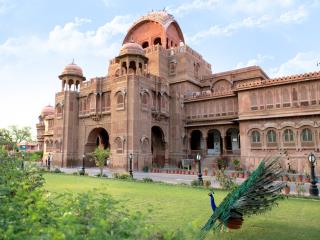Laxmi Niwas Palace

Built between 1898 and 1902, Laxmi Niwas Palace was commissioned by
Maharajah Sir Ganga Singh to serve as his royal residence. Designed by Sir
Samuel Swinton Jacob, Laxmi Niwas Palace is constructed in an Indo-Saracenic
style, an architectural movement popularized in the 19th century in British
India.
While driven by his vision of establishing a grand estate worthy of royalty,
the Maharajah of the former state of Bikaner was also motivated to build the
palace as a means to stimulate employment in the region. As a man of
impeccable taste and specific style, Maharajah Sir Ganga Singh carefully
supervised the artists, masons, and builders to ensure his concept was
properly executed.
The palace was constructed using pink sandstone, brought from the stone
quarries of Dulmera, boasting a brilliant palate to complement the intricate
symmetrical structural design. Boasting colonnaded corridors, canopied
balconies adorned with intricate filigree, and wooden and stone lattice
work, the brilliant craftsmanship of the estate's exterior was completed
with marble courtyards and whimsical fountains amid immaculate gardens.
Attributing to the Maharajah's specific artistic vision, the palace
interiors were equally vibrant, displaying carved friezes, ornate ceilings,
Usta artwork, and expansive golden frescoes and murals depicting cultural
scenes.
The magnificent palace was named after the Hindu Goddess of wealth,
prosperity, and beauty, Laxmi. As the consort of Narayana, the all-pervading
manifestation of The Supreme God Vishnu, Laxmi represents good luck and
fortune that radiates through the halls of the palace. Upon its completion,
plans were made to expand the estate into the much larger Lalgarh Palace,
presently comprised of several palace houses.
Used exclusively as the private residence for the Royal family and their
guests, Laxmi Niwas Palace commanded over Bikaner in all its opulence. With
a flair for hospitality, the Maharajah hosted numerous luminaries and
dignitaries, including King George V and Queen Mary, the King of Greece,
viceroys, fellow Maharajahs, and renowned statesmen.
At the turn of the 21st century, Laxmi Niwas Palace was converted into a
magnificent luxury hotel, celebrating its significant heritage with
thoughtfully-preserved historic elements.
Laxmi Niwas Palace, a charter member of Historic Hotels Worldwide since
2013, dates back to 1904.
Getting There
Bikaner Airport is
located 13 km from Bikaner. Currently,
Alliance Air operates
scheduled flight services to and from this Airport to Delhi. Air flight
services is play a major role in order to boost the tourism in the state.
Jodhpur Airport is another
airport near to Bikaner, it is well equipped with the latest facilities. You
can easily reach the airport through road via public transport. here one can
get many direct and indirect flights to different destinations like. You can
take flight from Delhi to Jodhpur, flights from Jaipur to Jodhpur and from
other major cities to reach Bikaner.
The city has two railway stations, namely, Bikaner Junction and Lalgarh
Railway Station. From here you can take trains to various destinations such
as Delhi, Jaipur, Jodhpur and many more.
Transport inside the city can be a big problem as buses are few and far
between and the ones that are, aren't too good. For sightseeing, rental
vehicles, tourist taxis and Rajasthan Tourist Development Corporation
conducted tours are available. Auto rickshaws are convenient and more
economical than cabs but be sure to fix fares beforehand or insist on the
use of the meter. A cheaper mode of travel around the city would be a cycle
rickshaw.
undo ...back